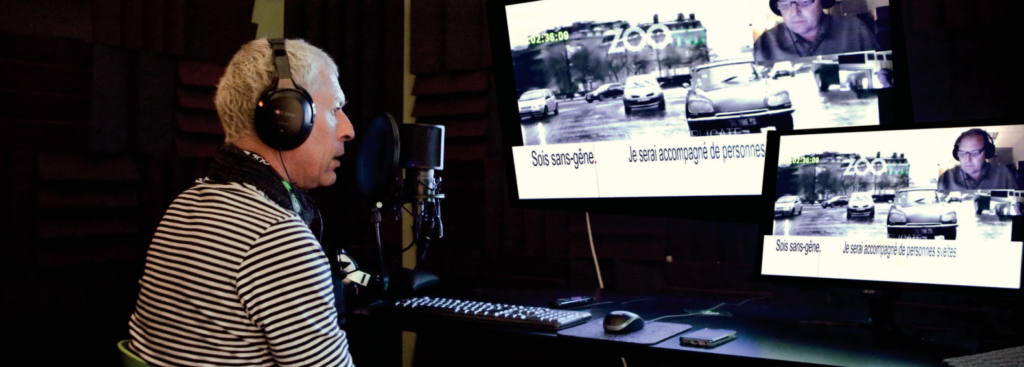HITS

M&E Journal: How Digital Demand Is Disrupting Dubbing
Story Highlights
By Dr. Stuart Green, CEO, ZOO Digital –
Thanks to the boom in popularity of digital channels and internet streaming services for film, TV and video, content owners are seeing more opportunities than ever to sell new titles and back catalog feature films and TV series in new territories.
This has led to a growing demand for content localization particularly across Europe, Middle East and Africa (EMEA) to the tune of $2 billion in 2016. What’s more, this is set to grow by 8 to 10 percent, reaching $2.5 billion annual spend before 2020, according to a June 2017 study conducted on behalf of the MESA Europe Content Localization Council.
To subtitle or dub?
The price tag attached to dubbing has had a major impact on whether content is subtitled or dubbed. This is on top of other considerations, such a title’s genre and audience preferences in particular territories. This is backed up by a study on dubbing and subtitling needs and practices in the European audiovisual industry by Media Consulting Group on behalf of the European Commission. The study estimated that only 20 percent of theatrical-first releases are being dubbed for European audiences, while MESA reports that dubbing represents 70 percent of annual spend.
The skills shortage
There are two key factors involved in making sure dubbing quality is up to scratch. Firstly, the script needs to be adapted accurately into the target language to make sure that the dialog shares the same linguistic meaning. Secondly, it’s about having the same emotional impact, thanks to voice artists who must also be skilled actors.
The growing demand for these specialist capabilities is causing concerns among some content producers for future supply. Jim Bottoms, executive director of MESA Europe said: “Already in some of the key markets there is a significant shortage of localization skills, and given the continued growth in demand, content producers and their supply partners are very keen to expand the talent pool to avoid serious capacity shortages.”
Quality is king
The scale and pace with which both new and catalog titles are being adapted for digital distribution has created other pressures for content owners.
Feature films and TV series are being delivered to more platforms and channels and localized into more languages while release windows are decreasing all the time. In addition, the quality requirements of leading streaming platforms are often higher than when pre-existing localizations were originally created, necessitating clean-up operations to bring the materials up to new standards. Despite the pressures due to timescales and budgets, quality of localized materials is something that content owners are unable to compromise.
“For me, quality always has to be the highest priority benchmark, it is the paramount consideration when looking at potential suppliers, as well as localization tools and technologies,” said Catherine Retat, a senior studio executive and co-chair of MESA Europe’s Localization Council.
A new era in subtitling
Despite there being a long-established entertainment localization sector, the last five years have seen new players enter the subtitling market on the back of growth in demand. Where the large incumbent providers are traditional bricks-and-mortar organizations, with multiple offices across key territories, the new entrants have tapped into the benefits of cloud technology and the gig economy to access a global network of freelance translators in a more efficient and scalable way.
By moving away from desktop tools such as spreadsheets and email, new cloud platforms for subtitling mean that capacity can respond more quickly to demand. The process can be managed with language specialists around the world able to work together online, leading to faster turnaround and higher quality.
 How dubbing is done
How dubbing is done
This innovative approach to subtitling offers great promise for tackling the rising demand for subtitling services.
What then of dubbing? Today dubbing is centered around a limited number of purpose-built, in-territory studios that provide multiple recording spaces, isolation booths, control rooms and the associated recording equipment (microphones, mixing desks, etc.)
In addition, these facilities are staffed with dubbing directors, recording engineers, mixing specialists and others engaged in the end-to-end script adaptation and audio production process. Each dubbing studio typically has a contact database of local voice actors in easy commuting distance.
Content owners usually select a separate dubbing partner for each territory. There are few multinational operations with dubbing studios across several countries that can provide a convenient way to dub into different languages using a single partner.
MESA Europe’s research indicated that, unlike subtitling, buyers of dubbing services prefer local or national vendors due to their proximity to suitable voice actors. The dubbing market profile is highly fragmented, with the top four vendors accounting for only 20 percent of the market by value.
Unlike subtitling, there has been little innovation in dubbing other than the evolution of general purpose tools, such as digital audio workstations. Consequently, the traditional dubbing process suffers from scalability issues, including:
A limited choice of vendors for content owners;
Capacity is determined by the available specialist recording space;
A lack of workflow management tools specifically designed for the dubbing process leads to recording errors and omissions;
Independent adaptation of scripts for each language across multiple dubbing studios leads to duplicated efforts;
There is a limited talent pool of voice actors linked to each dubbing studio resulting in the repeated use of the same voices across titles; and
There is a long turn-around time for projects from receipt of scripts to delivery of localized assets.
Disrupting dubbing
Following the success of innovations in subtitling, it makes sense that the dubbing process evolves to reflect the pace of change in digital entertainment. The challenge lies in how technology can take the strain bearing in mind the following requirements:
• Expansion of recording spaces – in contrast to the limited availability of dedicated entertainment dubbing studios, the potential for using non-specialist recording spaces, vocal booths and even home recording is significant. Subject to the availability of suitable equipment, such spaces give almost limitless capacity for voice capture.
• Dependence on audio engineering skills – the use of digital audio workstations in the traditional dubbing workflow means that a recording engineer is needed to cue takes and adjust levels. Such recording functions are about carrying out processes and are well suited to automation with the support of purpose-built software.
• Facilitating collaboration – the traditional dubbing workflow means that voice actors, dubbing directors, recording engineers and other participants must come together in the same location, with all the challenges of coordinating diaries and travel. Yet cloud computing can provide a way to work together online and scale up operations with a distributed team.
• Expansion of the voice talent pool – for as long as dubbing remains centered around physical locations, budget constrains will mean that voice talent will be limited to those who live close to studios to minimize travel and subsistence expenses. A cloud-based approach will widen participation to anyone within reach of a suitable recording space, offering opportunities to grow the pool of available talent and promote greater choice of voice actors.
• Origination of scripts – the traditional dubbing workflow results in duplication of effort as scripts are independently prepared and adapted for each language. With a centralized approach in the cloud, scripts in the same language can be shared and re-used for dubbing or subtitling and the original language script prepared to significantly speed up project turnaround times.
• Version control – scenes and dialog may change multiple times before a script is finalized. This makes version control challenging, yet having a central online system for managing the workflow from start to finish helps achieve consistency across languages.
• Eradication of recording oversights – in the traditional dubbing process lines of dialog are often missed and voice actors must be called back to the studio. A systematic approach, which uses technology to start a project based on the original language script, rules out the margin for error and avoids extra cost and delay.
• Security – in the current process, reference video materials are supplied to each dubbing studio. Watermarks and spoilers are used to protect content from the risk of leaks and piracy. The cloud affords far higher levels of protection – watermarks are personalized for individual recipients; two-factor authentication is required and user viewing can be tracked.
• Full client visibility – the conventional dubbing workflow is largely a black hole where the only way to review work in progress is to attend recording and mixing sessions. In the cloud, clients have full visibility. They can check project progress, review or approve material throughout the workflow.
Cloud computing is already successfully addressing the changing needs of subtitling. While dubbing has a significantly different workflow, involving many more participants and complex processes, cloud technology finally offers a way to disrupt the way foreign language soundtracks are produced and bring transformative change to the way dubbing is done.
—-
Click here to translate this article
Click here to download the complete .PDF version of this article
Click here to download the entire Winter 2018 M&E Journal









